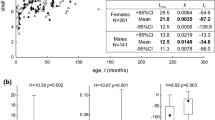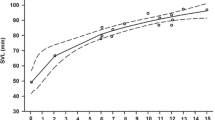Abstract
A two-year study on a field population of Ligia pallasii Brandt has shown that the isopods live for 1.5 to 2 years. Breeding occurs in the spring and early summer, with some females carrying winter broods of eggs. The mean length of breeding females is 22.5±2.2 mm (standard deviation) and the mean brood size is 48±11 eggs. Mature males are larger than mature females (900 and 300 mg live weight, respectively), and are disproportionately broader (31×17 mm and 22.5×9 mm, respectively). The larger size and breadth of the males is an adaptation for copulation, and may be atributed in some measure to slower growth of the female due to the extra energy demands of reproduction. The overall 1:1 ratio of males to females in the population represents the balance between an equal sex ratio in the immature stages, more females in the 18 to 24 mm length category, and more males in the larger length categories. This condition is attributed mainly to the faster growth of the males.
Similar content being viewed by others
Literature Cited
Abbott, C. H.: Shore isopods: niches occupied, and degrees of transition toward land life with special reference to the Family Ligydidae. Proc. Pacif. Sci. Congr. (No. 6) 3, 505–511 (1940).
Barnes, T. C.: Salt requirements and space orientation of the littoral isopod Ligia in Bermuda. Biol. Bull. mar. biol. Lab., Woods Hole 63, 496–504 (1932).
— Further observations on the salt requirements of Ligia in Bermuda. Biol. Bull. mar. biol. Lab., Woods Hole 66, 124–132 (1934).
—: Salt requirements and orientation of Ligia in Bermuda. III. Biol. Bull. mar. biol. Lab., Woods Hole 69, 259–268 (1935).
Carefoot, T. H.: Feeding, food preference, and the uptake of food energy by the supralittoral isopod Ligia pallasii. Mar. Biol. 18, 228–236 (1973).
Collinge, W. E.: The role of nutrition and temperature in sex determination in terrestrial Isopoda. Ann. Mag. nat. Hist. 14, 209–216 (1947).
Ellenby, C.: Body size in relation to oxygen consumption and pleopod beat in Ligia oceanica L.. J. exp. Biol. 28, 492–507 (1951).
Ellis, P. and W. D. Williams: The biology of Haloniscus searlei Chilton, an oniscid isopod living in Australian salt lakes. Aust. J. mar. Freshwat. Res. 21, 51–69 (1970).
Ellis, R. J.: A life history study of Asellus intermedius Forbes. Trans. Am. microsc. Soc. 80, 80–102 (1961).
—: Notes on the biology of the isopod Asellus tomalensis Harford in an intermittent pond. Trans. Am. microsc. Soc. 90, 51–61 (1971).
Harding, J. P.: The use of probability paper for the graphical analysis of polymodal frequency distributions. J. mar. biol. Ass. U.K. 28, 141–153 (1949).
Hatch, M. H.: The Chelifera and Isopoda of Washington and adjacent regions. Univ. Wash. Publs Biol. 10, 156–274 (1947).
Hatchett, S. P.: Biology of the Isopoda of Michigan. Ecol. Monogr. 17, 47–79 (1947).
Heeley, W.: Observations on the life-histories of some terrestrial isopods. Proc. zool. Soc. Lond. (Ser. B) 111, 79–149 (1941).
Hewitt, C. G.: Ligia. L.M.B.C. Mem. typ. Br. mar. Pl. Anim. 14, 1–37 (1907).
Holdich, D. M.: Reproduction, growth and bionomics of Dynamene bidentata (Crustacea: Isopoda). J. Zool. London 156, 137–153 (1968).
Howard, H. W.: Monogenic broods in Armadillidium vulgare Latr. Nature, Lond. 144, p. 979 (1939).
Jones, M. B. and E. Naylor: Breeding and bionomics of the British members of the Jaera albifrons group of species (Isopoda: Asellota). J. Zool. London 165, 183–199 (1971).
Markus, H. C.: Studies on the morphology and life history of the isopod, Mancasellus macrourus. Trans. Am. microsc. Soc. 49, 220–237 (1930).
Miller, M. A.: Comparative ecological studies on the terrestrial isopod Crustacea of the San Francisco Bay region. Univ. Calif. Publs Zool. 43, 113–141 (1938).
Naylor, E.: The life cycle of the isopod Idotea emarginata (Fabricius). J. Anim. Ecol. 24, 270–281 (1955).
Nicholls, A. G.: Studies on Ligia oceanica. I.A. Habitat and effect of change of environment on respiration. B. Observations on moulting and breeding. J. mar. biol. Ass. U.K. 17, 655–673 (1931).
Paris, O. H. and F. A. Pitelka: Population characteristics of the terrestrial isopod Armadillidium vulgare in California grassland. Ecology 43, 229–248 (1962).
Parry, G.: Osmotic and ionic regulation in the isopod crustacean Ligia oceanica. J. exp. Biol. 30, 567–574 (1953).
Prus, T.: The assimilation efficiency of Asellus aquaticus L. (Crustacea, Isopoda). Freshwat. Biol. 1, 287–305 (1971).
Richardson, H.: A monograph on the isopods of North America. Bull. U.S. natn. Mus. 54, 1–727 (1905).
Saito, S.: Structure and energetics of the population of Ligidium japonica (Isopoda) in a warm temperate forest ecosystem. Jap. J. Ecol. 15, 47–55 (1965).
Soldatova, I. N., E. A. Tsikhon-Lukanina, G. G. Nikolaeva and T. A. Lukasheva: On the transformation of the energy of food in marine crustaceans. [Russ.]. Okeanologija 9, 1087–1094 (1969).
Steel, E. A.: Some observations on the life history Asellus aquaticus (L.) and Asellus meridianus Racovitza (Crustacea: Isopoda). Proc. zool. Soc. Lond. 137, 71–87 (1961).
Steele, D. H. and V. J. Steele: The biology of Jaera spp. (Crustacea, Isopoda) in the northwestern Atlantic. 1. Jaera ischiosetosa. Can. J. Zool. 50, 205–211 (1972).
Todd, M. E.: Osmoregulation in Ligia oceanica and Idotea granulosa. J. exp. Biol. 40, 381–392 (1963).
Wilson, W. J.: Osmoregulatory capabilities in isopods: Ligia occidentalis and Ligia pallasii. Biol. Bull. mar. biol. Lab., Woods Hole 138, 96–108 (1970).
Author information
Authors and Affiliations
Additional information
Communicated by T. R. Parsons, Vancouver
Rights and permissions
About this article
Cite this article
Carefoot, T.H. Studies on the growth, reproduction, and life cycle of the supralittoral isopod Ligia pallasii . Marine Biology 18, 302–311 (1973). https://doi.org/10.1007/BF00347793
Accepted:
Issue Date:
DOI: https://doi.org/10.1007/BF00347793




